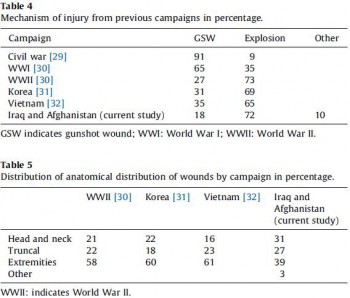12/06/2014
Traumatisé de guerre: Cela évolue
Systematic review of the prevalence and characteristics of battle casualties from NATO coalition forces in Iraq and Afghanistan
Hoencamp R. et All. Injury, Int. J. Care Injured 45 (2014) 1028–1034
Background: The North Atlantic Treaty Organization (NATO) coalition forces remain heavily committed on combat operations overseas. Understanding the prevalence and characteristics of battlefield injury of coalition partners is vital to combat casualty care performance improvement. The aim of this systematic review was to evaluate the prevalence and characteristics of battle casualties from NATO coalition partners in Iraq and Afghanistan. The primary outcome was mechanism of injury and the secondary outcome anatomical distribution of wounds.
Methods: This systematic review was performed based on all cohort studies concerning prevalence and characteristics of battlefield injury of coalition forces from Iraq and Afghanistan up to December 20th 2013. Studies were rated on the level of evidence provided according to criteria by the Centre for Evidence Based Medicine in Oxford. The methodological quality of observational comparative studies was assessed by the modified Newcastle-Ottawa Scale.
Results: Eight published articles, encompassing a total of n = 19,750 battle casualties, were systematically analyzed to achieve a summated outcome. There was heterogeneity among the included studies and there were major differences in inclusion and exclusion criteria regarding the target population among the included trials, introducing bias. The overall distribution in mechanism of injury was 18% gunshot wounds, 72% explosions and other 10%. The overall anatomical distribution of wounds was head and neck 31%, truncal 27%, extremity 39% and other 3%.
Conclusions: The mechanism of injury and anatomical distribution of wounds observed in the published
articles by NATO coalition partners regarding Iraq and Afghanistan differ from previous campaigns. There was a significant increase in the use of explosive mechanisms and a significant increase in the head and neck region compared with previous wars.


Les commentaires sont fermés.